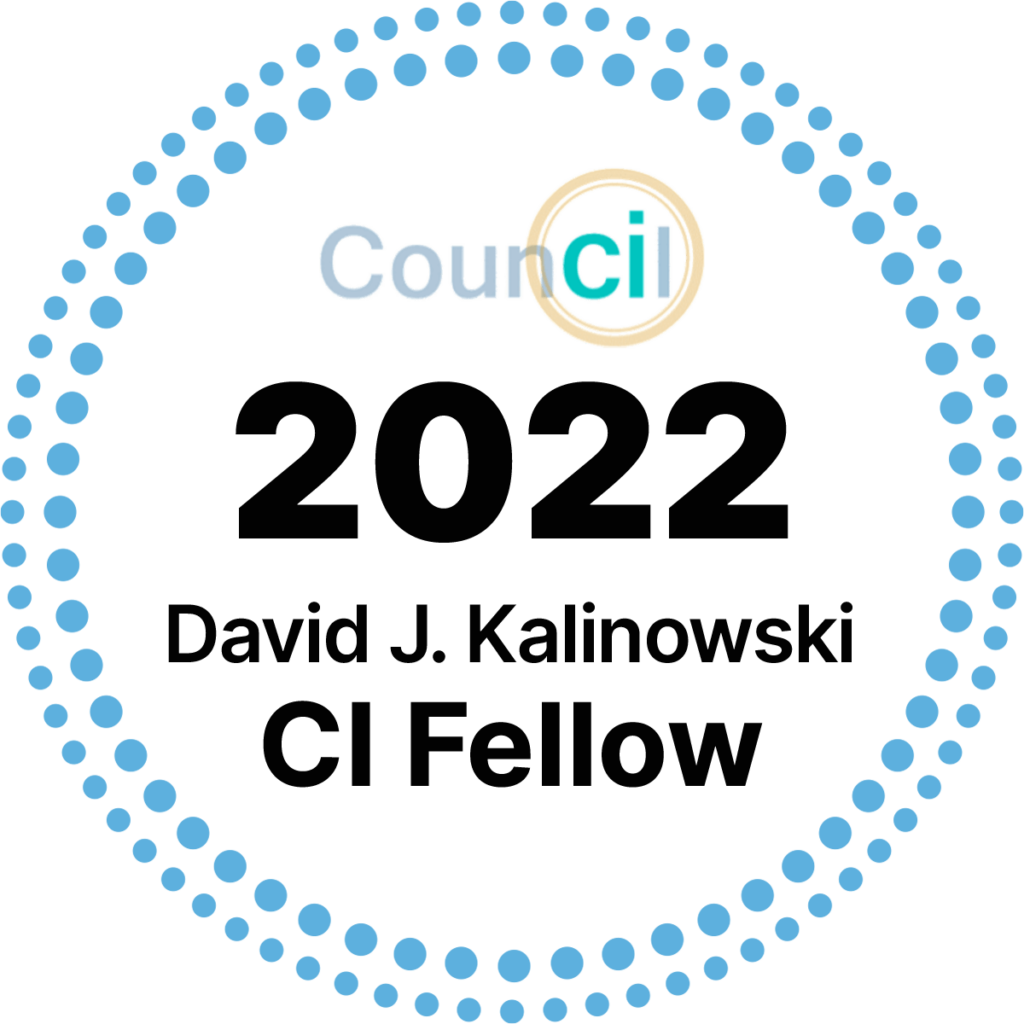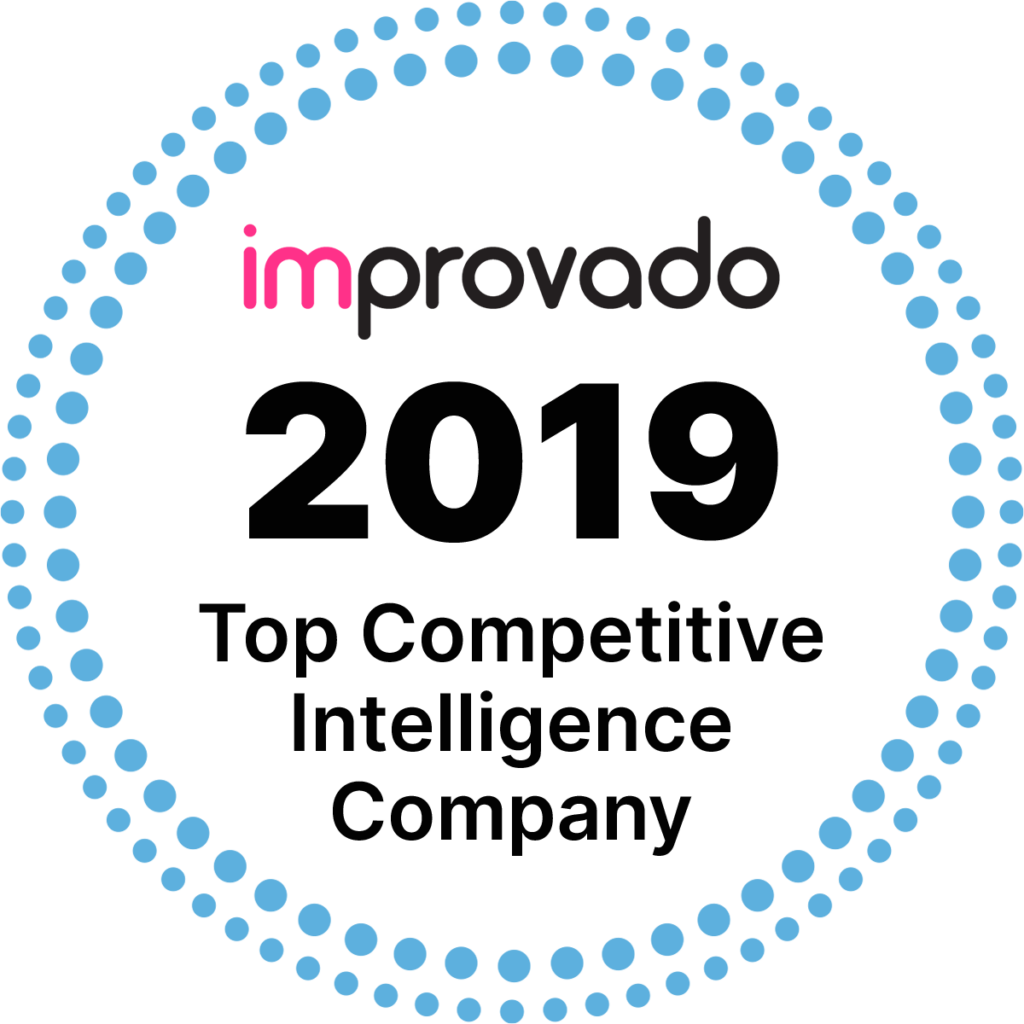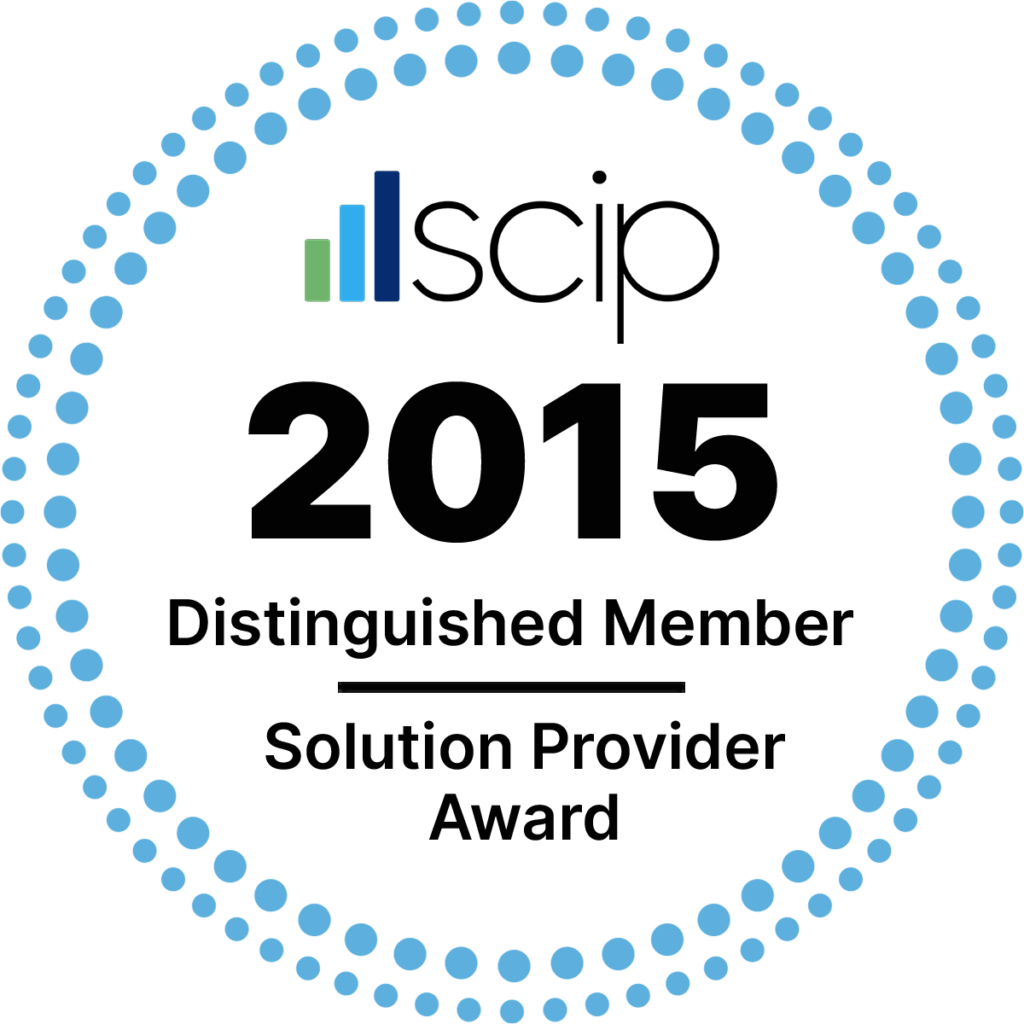Published: June 5, 2019
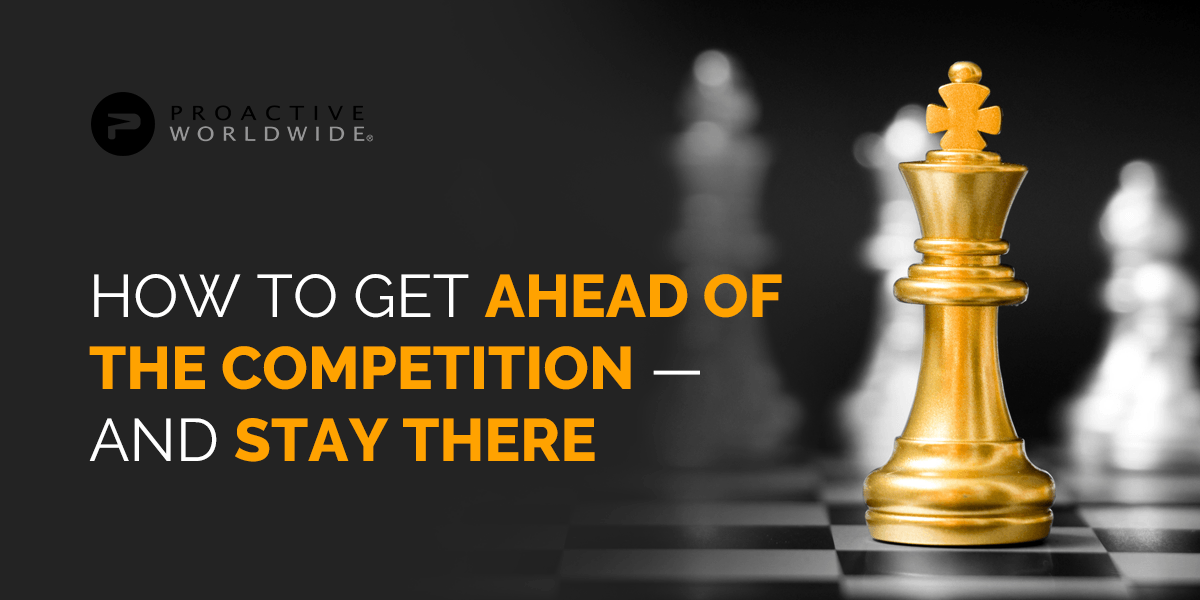
Organizations seeking to outpace the competition require ideas and strategies inspired beyond generalizations.
Broad analysis or pre-published, generic findings don’t cut it. To know how to beat the competition, businesses need growth-oriented, yet actionable, data-informing ways to get and stay ahead of key industry rivals. Such data needs to be tailored to that exact enterprise and its core competition, unearthing root opportunities for true market differentiation.
While many have heard of competitive benchmarking, few organizations have the roadmap — or the on-hand resources — to implement an immediate competitive intelligence and market analytics plan to their advantage. Read on to discover how your business can remedy this strategy gap and keep ahead of the competition, beginning today.
What Is Competitive Benchmarking?
Competitive benchmarking is when an organization initiates a systematic review of internal operations, structures and strategies, then compares its findings directly against top industry competitors.
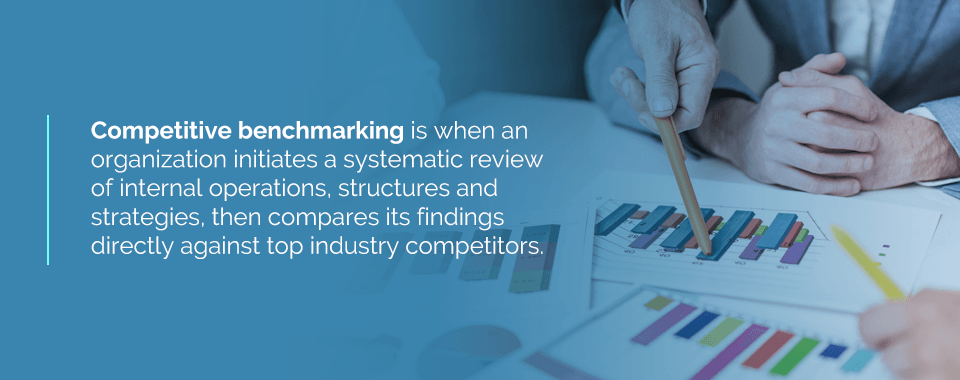
In other terms, it’s an analysis of vital KPIs of one organization against another’s, with the goal to temperature-check best practices to produce long-term, superior business results.
Benchmarked data comes from both external and internal sources. Most competitive analyses use a mix of methodologies to compare themselves with properly scaled competition, meaning others of similar size and stature. For example, it does a mom-and-pop diner no good to competitive benchmark against a national chain because the daily decisions necessary to run these businesses radically differ.
Competitive benchmarking strategies can measure and compare any of the following business domains:
- Sales strategies, operations and resources
- Marketing and advertising channels or campaigns
- Product or service lines, launches and offerings
- Go-to-market structures and timelines
- Pricing analysis
- Supply chain coordination and distribution strategies
- Talent acquisition and management
- And much more, all contingent on industry alignment, business scale and an organization’s outlined questions, concerns and goals
Business Benchmarking Strategies to Beat the Competition
The best business competition plans ground operational goals with actionable, practical data, drawing organizations their road map to unlock greater capabilities. Keep ahead of the competition by deploying any one of these top benchmarking and competitive intelligence strategies.

1. Hire a Competitive Intelligence (CI) Firm
Firms specializing in competitive profiling research, analysis and implementation make it their mission to sharpen the operational tools organizations already have — plus mitigate risks they may not see.
CI firms can specialize in particular industries, such as pharmaceutical competitive intelligence or financial services benchmarking. Other firms apply targeted CI research methodologies for clients regardless of industry, using those tactics to generate personalized strategies to remain competitive.
In hiring a CI research firm, businesses receive objective insights and expertise across critical business questions and domains. CI firms aggregate internal and external information to create hyper-targeted, tailored plans to close competitive gaps, as well as identify current or future risk categories. From these reports, organizations can draft their sharpest, most actionable operations and output goals, all informed by comparative data.
2. Conduct User Experience (UX) Groups to Understand Brand Perception
User experience groups are a primary research methodology with one core focus: understanding how real users of your products or services, both current and prospective, think and feel about your brand. It prioritizes the functional as well as psychological factors influencing user decisions, with a goal to use data gleaned from real user surveys, voice-of-customer interviews and focus groups to tailor tomorrow’s products, services and branding mechanisms.
UX groups focus on many variables that influence overall brand perception:
- Usability
- Navigability
- Findability
- Desirability
- Accessibility
- Trustworthiness
- Practicality
- Brand “personality”
- Overall perceived value
Armed with quantitative and qualitative UX data, organizations can implement new strategies to differentiate themselves from the competition — all with the task of remaining more relevant than their competitors in the eyes of the consumer.
3. Understand True Customer Expectations
Competitive benchmarking can assist in developing 360-degree profiles for various consumer segments.

Internally, competitive benchmarking allows organizations to understand their current customers better. More holistic customer profiles unlock what makes these consumer groups tick: what attracted them to your brand, what keeps them purchasing from you, their favorite products or services and — most importantly — why they picked you over the competition.
Externally, competitive consumer profiling research provides knowledge into your rivals’ customer segments. What draws them to others’ products or services? Is it price? Credibility? Market influence? Servicing affordances? Something intangible and different altogether? Keeping ahead of the competition means understanding them — namely, the consumer groups keeping them afloat.
4. Run a Structural Business Analysis
What makes the everyday operations in an office tick? Do people, processes and technology harmonize or hinder those operations, and where is there explicit process friction?
Structural business analyses provide the answers to questions like these, as well as outline action plans to see gaps and inefficiencies remedied. More specifically, a structural business analysis conducted internally or with the help of a hired CI firm can investigate the following compared to the competition:
- Organizational hierarchies
- Office technology
- Intra-department businesses processes, or workflows within a single department or team
- Inter-department business processes, or workflows across departments and teams
- Business partnerships and vendor relations
- Organizational policies and procedures
Key KPIs to conducting structural business analysis and comparing results to rivals might include:
- Process cost as a percent of revenue
- Process productivity increase percentages
- Cycle time reductions
- Unit cost reductions
- Percentage of rework attributable to process requirement
- Stakeholder and employee satisfaction rates
5. Review Sales Performance KPIs
Organizations measure sales performance according to their structure and goals. Varying departments will have diverging definitions, since each department has different levels of direct interaction and oversight into sales. For example, an IT department for a medical device company may not position every one of its workflows in correlation with boosting sales, yet the marketing and sales divisions rely on the technology and systems they support, so they are therefore related to sales performance.
Every function of a profitable business has some connection to sales. As such, performing competitive benchmarking helps determine processes and systems boosting overall profitability as it relates to sales.
Business competition studies can survey sales performance KPIs internally, then compare those KPIs with their competition, identifying ways to maximize operations and increase net sales profits. Consider measuring sales performance KPIs in a myriad of ways, from productivity rates to average lead costs, supplier operations, cycle times, working capital flows, customer value averages and many more.
Broken down even further, sales performance KPIs might include metrics like:
- Sales touchpoints such as calls, emails, etc. per order or per sales representative
- Sales by platform or contact method
- Value per sales transaction
- Quote-to-close ratios
- Sales funnel, pipeline conversion rates
- Customer lifetime value profiles
- And many more
6. Compare and Contrast Buyer Personas
Use real, quantitative data gathered from consumer analysis and user test groups to create your organization’s buyer personas — in other words, character types representing the core demographic makeup of your customer base.

Buyer persona data encompasses many factors. For example, a persona will have a set age, income, gender, education and geographic location, but also lifestyle information like hobbies, leisure activities, shopping habits, frequently visited websites, social media network usage and even internet search history.
Buyer personas help you further understand your market share and value differentiation compared to competitors. Through them, organizations identify the type of people their business is most likely to attract, as well as whom rivals attract, then integrating marketing strategies to convert personas away from those rivals.
7. Compare and Contrast Marketing Efforts
A business competition strategy would be remiss without competitive research and analysis into its marketing analytics, specifically exploring variables like marketing campaign metrics and channel usage strategies. Businesses can conduct side-by-side comparisons of key marketing metrics, including KPIs like:
- Marketing spend as a percent of revenue
- Marketing content performance
- Marketing spend per customer or per campaign
- FTEs per campaign launch
- Customer equity calculations
- Customer retention rates
- Customer satisfaction rates or rankings
- Marketing channel usage
- Marketing channel market voice
8. Study Your Share of Market Voice
Market voice studies directly compare your perceived industry authority and influence to the competition. Your market voice accounts for qualitative and quantitative data alike, from the number of social mentions or branded hashtags people use during a given period to website traffic increases or decreases after an event puts your industry in the public spotlight.
Market voice analysis involves understanding your overall market landscape. Promoting your market voice consists of understanding its current strengths and weaknesses, as well as identifying what PR strategies and platforms your core competition uses most often.
9. Perform a Sentiment Analysis
Sentiment analyses measure the tone of brand mentions on social media, blogs, other internet platforms and across general news and publicity outlets. More specifically, it compares how many negative mentions and impressions your brand holds compared to positive ones, allowing organizations to then interpret the root causes of each.

Once analyzed, sentiment analysis integrates into a brand’s overall “social listening” strategy, providing competitive insights into how to manage and interact with real consumers across online platforms. These interactions are imperative for overall brand perception, as well as differentiation between your business and your competition.
A sentiment analysis tends to complement market voice and market share benchmarking. It’s an important caveat to understanding how actual consumers perceive your brand’s personality compared to others’ — and the likelihood your marketing strategies will elicit desired goals from target consumer groups.
10. Complete a Price Audit, Then Offer Price-Matching Policies
Competitive price audits create a list of indexed product and service prices compared to identical or near-identical products and services on the retail market. It is one of the leading methodologies to better understanding your organization’s share in both current markets as well as prospective ones it hopes to enter.
Information gleaned from a competitive price audit can produce profit-maximizing new strategies across product fabrication, distribution, programs and offerings, resulting in measurable market gains over target competitors.
Conducting a price audit opens the door for organizations to offer sustainable price-matching policies as well, a competitive pricing strategy many traditional retailers are wielding to their advantage in an increasingly e-commerce-driven landscape.
Business Strategies to Stay Ahead of the Competition
Once an organization implements strategies to beat out the competition, they’ll require steps to remain there — leading their market across targeted metrics and domains. Businesses can beat and stay ahead of the competition using these competitive intelligence practices.

1. Measure Smarter, Not Harder
Too often, organizations fall into the trap of measuring everything and anything taking place within their walls. All business processes, policies, workflows, supply chains, productivity rates, consumer personas and internal hierarchies become subject to data surveillance for surveillance’s sake, rather than for pre-structured, critically insightful plans with actionable end goals.
Metric-savvy organizations are those with the right finesse to know which metrics and KPIs to track. They use both ongoing competitive profiling tactics to unearth specific, pinpointed data sets leading to functional interpretations. What’s more, they assign measurable metrics to every new business initiative or idea — measurable metrics compatible with overall organizational goals, not out of sync or detracting from them.
2. Integrate Findings Into Executive Summaries and Employee Portals
Staying ahead of the competition relies on smooth, streamlined communication between all levels of employee stakeholders. From C-suite executives and the boards they report to down to the most recent hires, everyone should have access to high-level summaries of competitive intelligence and market intelligence findings.

Include key findings and recommendations from CI research in easy-to-access and frequently updated platforms. Ensure all published findings include targeted suggestions and references written using results-oriented, enterprise-wide business terms. This bridges information gaps between departments and teams, plus conveys the relevance behind much of the comparative analysis and hard data you are currently gleaning via benchmarking programs. Most importantly, they instill the value of measurable competitive intelligence, helping teach the gravity of research and profiling strategies within every department’s work.
3. Maintain a Persona-Driven, Value-Based Unique Selling Proposition (USP)
Successful USPs are innately contingent on market differentiation research. The findings from initiated user group surveys to market voice research to conducted price audits and market performance sentiment all inform an organization’s true USP, rather than relying on guesswork or projective desires for what their USP should be.
USPs should also speak to customer personas, the real people with real, measurable wants, fears, principles and pain points engaging with your brand. Staying ahead of the competition requires understanding what those target consumers genuinely want, then positioning clear and value-based USPs that speaks directly to it.
Distinct, persona-driven USPs are a key differentiator behind an organization and one of the leading ways to nurture positive brand awareness, recall and sentiment.
4. Monitor Competitors’ Repetitive Behaviors
Consider the core business domains and departments your organization — as well as your competition — relies on to achieve its principal day-to-day operations:
- Product research and development
- Marketing
- Sales
- Customer service and support
- Finances
- Talent acquisition
- Supply chain, resource and vendor management
- Information technology
These operations are the ones resulting in your ability to deliver the goods and services tied to your brand. As such, understanding what processes your competitors continually deploy to accomplish their work underpins your ability to outperform that competition. In other words, frequent competitor operational analysis allows organizations to forecast competitor activities better and results, then beat them to it.
What’s more, ongoing competitive benchmarking allows organizations to identify their opportunity gaps. Once equipped with this knowledge, enterprises can more readily tailor processes they currently court, as well as preemptively manage blind spots to adopt growth initiatives.
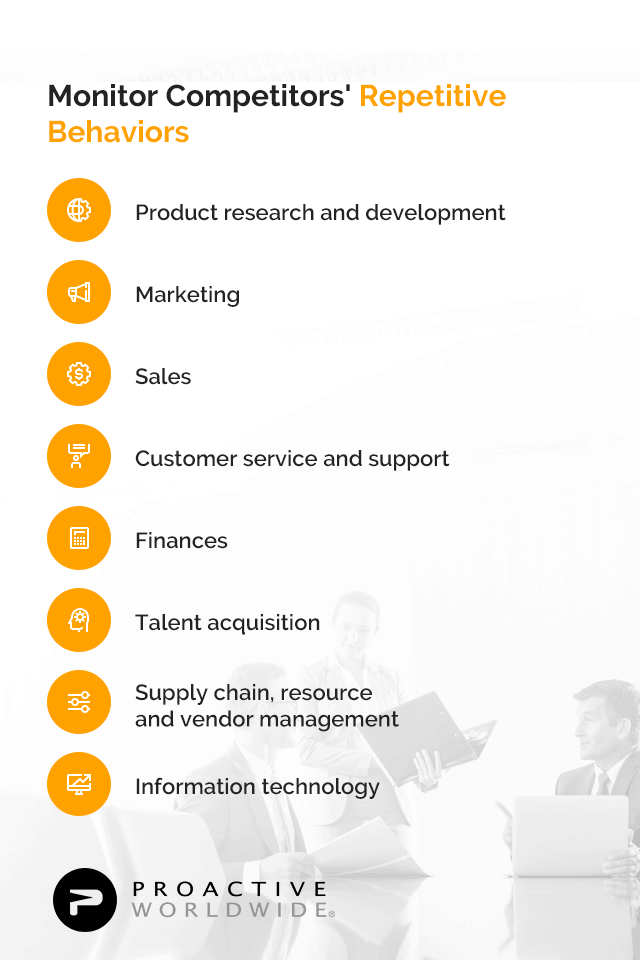
Organizations that hire an independent CI firm have an innate advantage in assessing competitor repetitions. Competitive intelligence and competitive market agencies have more systems and resources in place to conduct repetitive behavioral analysis across target business domains, funneling their findings into intelligent and actionable reports.
5. Consider Entering a New Market
Proactive competitive benchmarking empowers organizations to extend into new business markets — markets it’s already had in sight as well as those it may have undervalued.
Locally, regionally or internationally, competitive business analysis scaffolds what a risk-mitigating market entry plan looks like. More specifically, these plans allow organization leaders and stakeholders to create and execute the following market entry steps with confidence:
- Overall market landscape mapping, including size, risks, disruptions and segments
- Key buyer personas in those market segments
- Current competitors, both established and up-and-coming
- Common competitor business practices and strategies
- Blind spots and success patterns in a competitor’s business practices and strategies
- Cultural values, norms and beliefs shaping new markets and its consumers
6. Perform Frequent Technology Audits
Technology audits allow organizations to survey the functionality of their current IT infrastructure. With technology increasingly defining both professional and personal activities, it’s imperative for enterprises to remain proactive in the efficiencies, optimizations and adoption rates of any new enterprise hardware or software.

Frequent technology audits are also an underused competitive strategy. They ground any formal structural business analyses your organization performs, which study and measure competitors’ technology usage and provide a compass to orient your enterprise CI platforms. They can also help deter wasteful spending on trendy equipment and legacy systems alike, as benchmarked IT information reveals the financial and operational realities associated with each in your industry.
7. Support Continual Consumer Feedback Loops
Organizations have more methods than ever to support situational, structured or ongoing activities to understand consumers better. These activities are part of its larger customer insights strategy, which provides in-depth awareness of what real people think and feel about your brand, as well as problems they’ve experienced or stand-out, positive interactions they’ve had across touchpoints.
For example, businesses can conduct evidence-based customer feedback programs through:
- Response surveys, online, over the phone or in person
- User experience groups, in person or in the field, transactional or ongoing
- Video-recorded observations of test user groups and customer reactions
- Voice-of-customer interviews with individuals or groups
Quantitative and qualitative findings from these research methods funnel into strategic, customer-centric business decisions that further differentiate you from the competition. Whether devised entirely internally or with the assistance of a CI firm, consumer feedback studies and loops help pinpoint current strengths, in addition to weaknesses and growth opportunities for your products and services, all straight from those whose perspective on these matters means most. These measures directly influence positive, previously benchmarked metrics such as customer retention rates, customer satisfaction ratings, upsell or cross-sell conversion rates and customer equity calculations.
8. Support Professional Development Initiatives
Another overlooked business competition strategy involves little extraneous research or extra development to implement. It prioritizes something your organization already has set in place and relies upon each and every day to function: your employees.
The vast majority — 89 percent — of millennial workers rate professional development and learning opportunities as important when citing their overall job satisfaction. This number represents an uptick from the 69 percent of non-millennials, namely gen-Xers and working baby boomers, who place the same emphasis on these employee benefits.
Further studies promote the importance of satisfied workers with satisfactory outputs. Organizations that make a point to nurture their employees through career-enriching professional development opportunities will court a more efficient, productive, creative and motivated workforce — which, in turn, creates a more talented workforce fueling further competitive business advantages.
9. Promote a Healthy Workplace
In addition to professional development opportunities, research continues to prove the financial value of a balanced workplace culture.
To promote a healthy workplace, organizations must first understand what exactly their employees consider ideal office conditions. Your business should devise a similar approach to garnering employee satisfaction and retention feedback as you do to attracting and retaining customers. From anonymous surveys to hiring third-party CI consultants to conduct group interviews, businesses can gauge employee satisfaction with work policies, workplace flexibility, leadership, policy and process transparency, training, support and overall work/life balance.
These findings motivate organizational and environmental changes to maximize a workforce from the inside out, giving organizations another competitive advantage.
Contact Proactive Worldwide for Integrated, Specialized Strategies to Remain Competitive in Your Industry
As a global leader in intelligence-based strategic planning, competitive market intelligence and customer insights, Proactive Worldwide consultants have one goal: Help organizations refine and reinstate business competition strategies to not only get ahead of the competition — but to stay ahead.
If you’re wondering how to remain competitive in your market segment, contact one of our CI representatives to get started.





